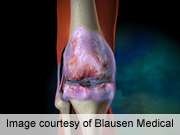For patients with knee osteoarthritis, the lack of correlation between clinical pain and radiographic evidence of disease severity may be due to central sensitization, according to a study published online Sept. 7 in Arthritis & Rheumatism.
(HealthDay)—For patients with knee osteoarthritis (K-OA), the lack of correlation between clinical pain and radiographic evidence of disease severity may be due to central sensitization, according to a study published online Sept. 7 in Arthritis & Rheumatism.
Patrick H. Finan, Ph.D., from Johns Hopkins University in Baltimore, and colleagues conducted a study involving 113 participants with K-OA (67 percent women; mean age, 61.05 ± 8.93 years). The Kellgren-Lawrence scale was used to grade radiographic joint pathology. Quantitative sensory testing, including heat and pressure pain threshold, tonic suprathreshold pain (cold pressor test), and repeated phasic suprathreshold mechanical and thermal pain were used to index central sensitization. Patients were stratified into four groups based on clinical knee pain and knee grade scores: Low Pain/Low Knee Grade (24 participants), High Pain/Low Knee Grade (30), Low Pain/High Knee Grade (27), and High Pain/High Knee Grade (32).
The researchers found that the Low Pain/High Knee Grade group was less pain sensitive, while the High Pain/Low Knee Grade group had significantly heightened pain sensitivity. These differences persisted even after adjustment for differences on psychosocial measures, age, sex, and race.
"We have identified a subgroup of K-OA patients who display abnormalities in pain processing consistent with central sensitization, as well as a subgroup of patients who may be resilient to these abnormalities despite prominent joint degeneration," the authors write. "The findings provide support for the notion that central sensitization is an endophenotype for chronic pain in K-OA and contribute to the ongoing debate surrounding the variable association of clinical pain and radiographic severity of K-OA pathology."
More information:
Abstract
Full Text (subscription or payment may be required)
Journal information: Arthritis & Rheumatism
Copyright © 2012 HealthDay. All rights reserved.




















